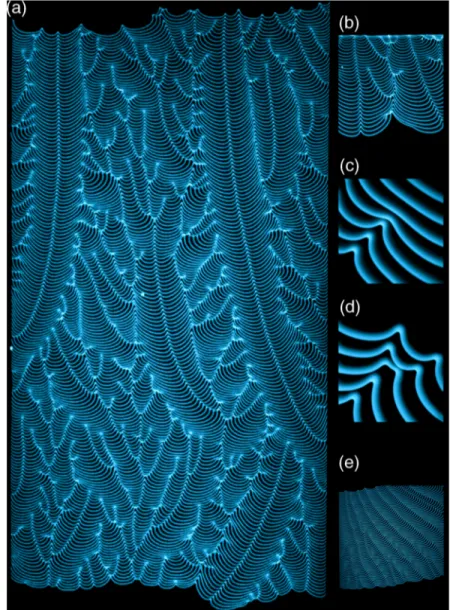HAL Id: hal-01216247
https://hal.archives-ouvertes.fr/hal-01216247
Submitted on 16 Oct 2015
HAL is a multi-disciplinary open access
archive for the deposit and dissemination of
sci-entific research documents, whether they are
pub-lished or not. The documents may come from
teaching and research institutions in France or
abroad, or from public or private research centers.
L’archive ouverte pluridisciplinaire HAL, est
destinée au dépôt et à la diffusion de documents
scientifiques de niveau recherche, publiés ou non,
émanant des établissements d’enseignement et de
recherche français ou étrangers, des laboratoires
publics ou privés.
Experimental two dimensional cellular flames
C. Almarcha, J. Quinard, B. Denet, E. Al-Sarraf, J. M. Laugier, E. Villermaux
To cite this version:
C. Almarcha, J. Quinard, B. Denet, E. Al-Sarraf, J. M. Laugier, et al.. Experimental two
dimen-sional cellular flames. Physics of Fluids, American Institute of Physics, 2015, 27 (9), pp.091110.
�10.1063/1.4930914�. �hal-01216247�
Experimental two dimensional cellular flames
C. Almarcha, J. Quinard, B. Denet, E. Al-Sarraf, J. M. Laugier, and E. Villermaux
Citation: Physics of Fluids 27, 091110 (2015); doi: 10.1063/1.4930914
View online: http://dx.doi.org/10.1063/1.4930914
View Table of Contents: http://scitation.aip.org/content/aip/journal/pof2/27/9?ver=pdfcov
Published by the AIP Publishing
Articles you may be interested in
Ignition sequence of an annular multi-injector combustor
Phys. Fluids 26, 091106 (2014); 10.1063/1.4893452
Comparative analysis of low- and high-swirl confined flames and jets by proper orthogonal and dynamic mode decompositions
Phys. Fluids 26, 065109 (2014); 10.1063/1.4884915
Two-dimensional direct numerical simulation evaluation of the flame-surface density model for flames developing from an ignition kernel in lean methane/air mixtures under engine conditions
Phys. Fluids 24, 105108 (2012); 10.1063/1.4757655
Double conditioning of reactive scalar transport equations in turbulent nonpremixed flames
Phys. Fluids 16, 2640 (2004); 10.1063/1.1758219
Diffusion flame in a two-dimensional, accelerating mixing layer
Phys. Fluids 9, 2617 (1997); 10.1063/1.869378
This article is copyrighted as indicated in the article. Reuse of AIP content is subject to the terms at: http://scitation.aip.org/termsconditions. Downloaded to IP: 147.94.56.75 On: Fri, 25 Sep 2015 13:19:38
PHYSICS OF FLUIDS 27, 091110 (2015)
FIG. 1. (a) Downward propagation of a stoichiometric premixed propane air flame in a vertically oriented Hele-Shaw cell. (b) Destabilization of a flat initial condition. (c) Cusp creation. (d) Cusps merging. (e) Lean flame close to the stability threshold.http://dx.doi.org/10.1103/APS.DFD.2014.GFM.P0036.
Experimental two dimensional cellular flames
C. Almarcha,1J. Quinard,1B. Denet,1E. Al-Sarraf,1J. M. Laugier,2 and E. Villermaux1,3
1Aix Marseille Université, CNRS, Centrale Marseille, IRPHE UMR 7342,
13384 Marseille, France
2Aix Marseille Université, CNRS, PIIM UMR 7345, 13397 Marseille, France 3Institut Universitaire de France, Paris, France
(Received 24 August 2015; published online 24 September 2015) [http://dx.doi.org/10.1063/1.4930914]
Premixed flames, where fuel and oxidizer are mixed prior to combustion, are widely used in gas turbines or internal combustion engines like spark ignition engines since they provide a practical 1070-6631/2015/27(9)/091110/2 27, 091110-1 © Author(s) 2015
This article is copyrighted as indicated in the article. Reuse of AIP content is subject to the terms at: http://scitation.aip.org/termsconditions. Downloaded to IP: 147.94.56.75 On: Fri, 25 Sep 2015 13:19:38
091110-2 Almarcha et al. Phys. Fluids 27, 091110 (2015)
mean to control the rate of combustion and lead generally to lower pollutant emissions, particularly for lean flames. However, thermal and hydrodynamical effects distort inherently the flame front, which generically presents a collection of cells, separated by cusps, merging and birthing at random and having a broad distribution of sizes. Studying this wrinkling in the flamelet regime, for low turbulent velocities not influencing the inner structure of the flame, is of prime importance as it rules the global velocity of the flame, an information also useful for calibrating numerical simulations.1
The description of the flame propagation and its dynamics is difficult in usual cases, such as propagation in cylindrical tubes2and deserves a dedicated experimental facility allowing for quan-titative imaging. For this purpose, a vertically oriented Hele-Shaw cell (two glass plates separated by a thin gap of 5 mm, 50 cm wide, and 150 cm in height) has been used. It is filled with a mixture of propane and air which is ignited at the top of the cell. The propagation of the flame along the cell in a quasi two-dimensional fashion allows for the precise analysis of its corrugations from the wrinkling of an initially flat flame front (Fig.1(b)) to the steady wrinkled regime (Fig.1(a)). The corresponding space-time diagrams illustrating the cusps dynamics have been obtained for stoichiometric propane air flames, diluted with nitrogen in the second case. They are constructed by superimposing the pictures of the front taken with a high speed camera at successive instants of times. The fields of view are, respectively, 12 cm wide and 50 cm wide. The frame rates are, respectively, 100 images/s and 60 images/s.
The key elements for understanding the statistical features of the front are the formation (Fig.1(c)) and merging (Fig.1(d)) of the cusps. These two concomitant and competing processes rule the distribution of the sizes of the cells, a distribution which appears to be identical for a large variety of gas mixture provided that the flame is unstable enough, i.e., not too close from the stability threshold. In that later case, most of the cells have the same size, as seen in Fig.1(e)
(equivalence ratio 0.66, field of view 43 cm wide, and recorded at 25 fps).
This research is supported by Agence Nationale pour la Recherche (No. ANR-14-CE05-0006).
1M. Philip, M. Boileau, R. Vicquelin, T. Schmitt, D. Durox, J. F. Bourgoin, and A. Candel, “Ignition sequence of an annular
multi-injector combustor,”Phys. Fluids26, 091106 (2014).
2C. Almarcha, B. Denet, and J. Quinard, “Premixed flames propagating freely in tubes,”Combust. Flame162, 1225-1233
(2015).
This article is copyrighted as indicated in the article. Reuse of AIP content is subject to the terms at: http://scitation.aip.org/termsconditions. Downloaded to IP: 147.94.56.75 On: Fri, 25 Sep 2015 13:19:38
